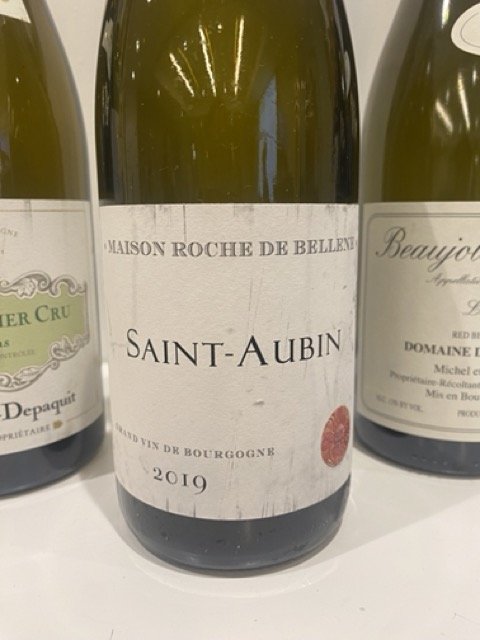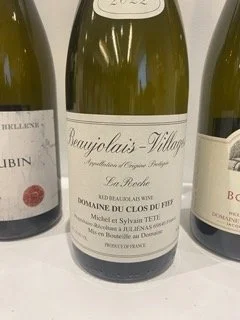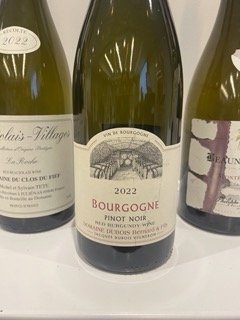Wine Tasting: Burgundy
When talking about wines from the French wine region of Burgundy (AKA Bourgogne), there really are only two main grape varieties to remember: Pinot Noir and Chardonnay. Located in the east-central part of France, Burgundy has 5 primary wine growing areas (not including Beaujolais and Châtillonnais): Chablis, Côte de Nuits, Côte de Baune, Côte Chalonnaise, and Mâconnais. Over 200 million years ago (enter: Supercontinent), this region was part of a vast, tropical sea. Since then, it’s transformed the seabed into limestone soils - the secret behind the zesty minerality so known in Burgundy wines.
Chablis, Premier Cru, Les Vaillons, Domaine Long-Depquit (A. Bichot), 2020
Located on the left bank of the Serein River on the outskirts of Chablis, “Les Vaillons” gives us a classic example of the region. The plot is on the slopes of the Valvan valley, right in the middle of the Premier Cru vineyard in “Les Epinottes”. Generally, colder climates (like that of Chablis) yields underripe grapes, leading to higher acidity.
Rich yellow in color, this Premier Cru has a bit of a chalky mouthfeel (perhaps due, in part, to it’s location along the Serein River?). Floral aromas, with a hint of fresh fruits - peaches, lemon or pear. It has a medium, acidic attack, balanced by fruity notes of peach, apples and pears. The finish is well-rounded with a hint of mineral. This would pair well with seafoods and white meats. Maybe event some fresh goat cheese to pair with the chalky texture and tangy notes in the wine.
Saint-Aubin, Maison Roche de Bellene, 2019
Saint-Aubin is a village tucked in a side valley between Meursault and Puligny-Montrachet - in the southern end of the Côte de Baune. A large portion (two thirds) of the vineyard area is designated Premier Cru, Chardonnay being the predominant grape variety. The appellation is well-known for it’s pleasing, affordable white wines.
Young chardonnay (great rapper name, tbh) from St. Aubin tend to have notes of white flowers, citrus, pear and wet stone. With age, they typically have rich aromas of beeswax, honey and marzipan.
Spicy, toasted aroma with maybe a hint of eucalyptus. Light acidity with a woody bitter taste and notes of ripe fruits. Longer finish with earthy notes. Would pair well with buttery dishes, roasted vegetables and roasted chicken.
Beaujolais-Villages, “La Roche”, Domaine du Clos du Fief (Michel Tête), 2022
Beaujolais is the southern most wine growing region in Burgundy (though it’s climate and wine produced differ significantly from what is typical of Burgundy). Beaujolais produces light, dry red wines from Gamay. Located on the far northwest sector of Beaujolais, Domaine du Clos du Fief is run by a father-son duo, Michel Tête and his son Sylvain. It’s a rare 4th generation Cru estate with villages that date back more than 2,000 years ago.
Bright pruple in color. Fragrant violets, red fruits, berries and red cherries. Very light tannins, refreshing taste of sour, juicy red fruits with an acidic finish.
Bourgogne, Pinot Noir, Domaine Bernard Dubois, 2022
Domaine Bernard Dubois is a tiny domaine of 7 hectares based in the village of Chorey-Les Beaune (just below Clos Margot). The current owner and winemaker is the 5th generation in his family to make wine in the village, focusing on creating terroir-pure wines around Chorey and Savigny, with sustainable practices and small yields. Once in the cellar, extraction is kept to absolute minimum - unfined and unfiltered, only indigenous yeasts are used and wines are aged and fermented in barrel.
Burgundian reds are ultra-dependent on their terroir to give them nuances in flavor. They’re typically lighter with medium acid and lower tannins. Pinot Noir is almost always the grape of choice in Burgundy (with the large exception being Gamay used in the South).
Almost savory on the nose (maybe notes of tomato?), as well as woody and plum aromas. Medium bodied with good tannin structure. Tastes of bitter tannin and cherry tart with earthy notes being most forward. Long to medium finish. Would pair well with chicken, any cooked tomato sauces/dishes, game and veal.
Beaune Premier Cru, Monté Rouge, Philip le Hardi, 2019
Domaine du Châteu Philippe le Hardi was once the home of the first Duke of Burgundy and is now one of Burgundy’s most prestigious producers. Their 200+ acres of vineyards throughout the Côte d’Or and Côte Chalonnaise produce wines that are distinct and reflect each vineyard’s terroir and climates. Located in Beaune, “Montée Rouge” refers to the slope of the Mountain of Baune and color of the soil. The red earth is due to the marl - a natural mixture of red clay and winestone.
Dark, cherry color. Aromas of black cherry, spices, cedar, and tobacco. Fresh tasting with notes of cherry (slightly spicy), which balances the well structured tannins. Complex and concentrated but not overpoweringly so. Would pair well with braised beef dishes, rich vegetable dishes and earthy, funky cheeses.




